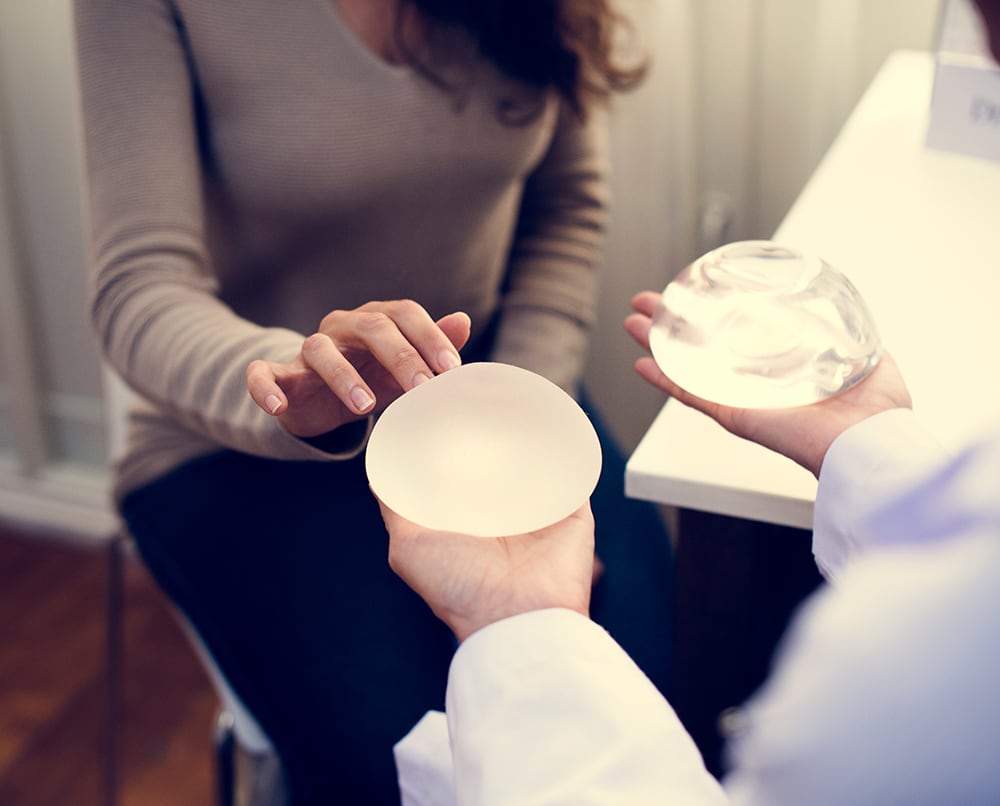Breast Reconstruction
With the enhanced techniques in early detection of breast cancer throughout the United States, many women who are newly facing a breast cancer diagnosis find that they are candidates for lumpectomy and radiation instead of mastectomy. Nevertheless, some women still find that the optimal treatment for their breast cancer may require mastectomy, as determined by their oncologist and surgeon. For those women, breast reconstruction surgery may be an option both in the immediate setting at the time of mastectomy, or subsequently several months later. Breast reconstruction can improve the quality of life of many women by restoring balance and symmetry, allowing a woman to shed her need for an external prosthesis, and heightening both self-esteem and confidence by recovering a sense of completeness and normalcy.
Explore Topics On This Page:

Quick Facts About Breast Reconstruction Procedures
- Sedation: General anesthesia
- Potential Benefits: Restoration of physique and body image following breast cancer recovery
- Potential Risks: Soreness, swelling, bruising; (less commonly) infection, fatigue, loss of nipple sensation, problems with bleeding
- Procedure Length: Variable
- Recovery: Typically one week off of work; regular activities can often be resumed within six to eight weeks
What Are the Benefits of Breast Reconstruction?
When performed by a qualified breast surgeon with decades of experience, breast reconstruction can offer benefits such as:
- Enhanced (e.g. fuller, more proportionate, more symmetrical, or more natural-looking) appearance of the post-cancer bustline
- Significantly improved self-image and well-being
- A customizable procedure with many strategies available
Personal circumstances and individual preferences play major roles in deciding if and when breast reconstruction is the right choice, as well as the surgical methods that can be employed during the procedure. During a thorough consultation, our experienced plastic surgeons will review your medical history and assess your unique needs for breast reconstruction. We will ask you about your concerns and preferences and recommend the most ideal options for reconstruction based on your health, body type, lifestyle, and surgical goals. Moreover, we would be glad to communicate with oncologists or other members of your healthcare team at any point.
What Are My Breast Reconstruction Options?
Tissue Flap Reconstruction (Autologous Reconstruction)
A tissue flap procedure uses a woman’s own tissue to reconstruct one or both breasts. Also referred to as autologous breast reconstruction, this option utilizes tissue from other parts of the body, such as the abdomen, back, thighs, or buttocks, to build the new breast mound. While a reconstructed breast will never exactly mimic a natural breast in appearance or feel, tissue flap reconstruction can allow for a more natural-looking breast reconstruction than other reconstruction options. Additionally, the resulting breast from a flap procedure can more closely resemble a natural breast in behavior, as breasts formed by a woman’s own tissue typically shrink or grow proportional to an individual’s weight fluctuation. Because the flaps used in autologous breast reconstruction require healthy blood vessels for the tissue’s blood supply, some patients may not be optimal candidates for a tissue flap procedure. Factors taken into consideration include tobacco use, a history of uncontrolled diabetes, poor blood circulation (vascular disease), or connective tissue diseases.
Depending on the location of the donor site, tissue flap techniques employed may include:
- TRAM (transverse rectus abdominis muscle) or DIEP (deep inferior epigastric perforator): Utilized most commonly, TRAM and DIEP flaps use tissue from the abdomen to form the new breast. While a TRAM flap transfers muscle, skin, and fat to the chest for breast reconstruction, a DIEP flap relocates only skin and fat and is useful when muscle transfer is not necessary.
- Latissimus dorsi flaps: This technique borrows tissue from the upper back and transfers blood vessels, skin, muscles, and fat to the chest in order to rebuild the breast. Latissimus dorsi flaps can be an ideal reconstruction option for women who may not be good candidates for TRAM or DIEP flaps due to inadequate donor tissue on the abdomen, but often require an underlying breast implant for sufficient volume.
- SGAP (superior gluteal artery perforator): SGAP flaps transfer skin and fat from the buttocks in order to reconstruct the breast mound. Though used less often, SGAP flaps can be used as an alternative to TRAM or DIEP flaps when the abdominal tissue is not suitable as a donor site.
- TUG (transverse upper gracilis): TUG flaps use tissue from the inner thigh, and are generally most successful for women with a small amount of breast volume to recreate. TUG techniques are utilized when donor tissue in the abdomen, upper back, or buttocks is insufficient to reconstruct the new breast.
Implant-Based Reconstruction

For some women, an implant may be a more beneficial option to recreate the new breast. Depending on each patient’s unique needs, implant-based reconstruction can often be performed at the same time as cancer removal surgery (mastectomy). A tissue expander may be required if the patient is interested in a larger final breast size. Fat grafting may be used to thicken the layer of coverage over the breast implant(s) in the event that a woman’s skin tissue is too thin.
Today there are more breast implant options than ever before. Implants can be textured or smooth, round or anatomic, or saline-filled or silicone gel-filled. They are available in all sizes, shapes, and degrees of projection to accommodate each woman’s unique anatomy, needs, and desires for enhancement. Anatomic or shaped implants have a textured surface to help achieve better stability within the breast to avoid unwanted shifting or movement. A smooth round implant is the most popular choice for many women because it typically moves slightly with a woman’s breast and more accurately resembles the natural breast.
When Is the Best Time For Breast Reconstruction?
Patients may have a choice between starting the breast reconstruction process immediately after cancer treatment surgery or delaying the procedure to a later time. This decision is typically made according to an individual’s preference, the nature of their cancer, and their overall physical and emotional health. In the vast majority of cases, barring extenuating circumstances, immediate breast reconstruction at the time of mastectomy—or oncoplastic reconstruction at the time of lumpectomy—is offered to the patient. This strategy is known as “immediate reconstruction,” whereas procedures done after the mastectomy are referred to as “delayed reconstructions.”*
Considerations for Breast Reconstruction
Alongside creating an ideal timeline for the surgery, breast reconstruction requires careful consideration of a number of additional factors. While the procedural outcome can be extremely rewarding for women who have lost one or both breasts to mastectomy—or have a deformed breast appearance from lumpectomy, injury, or a previous surgery—breast reconstruction is an extremely personal decision. Considerations to take into account include:
- The potential length of the process, particularly if additional cancer treatment is necessary, such as chemotherapy, radiation, or both.
- Any existing medical conditions, and your overall physical and emotional health
- Your willingness to potentially undergo more than one surgery as part of your reconstruction
- Your willingness to make decisions regarding breast reconstruction while being treated for cancer (if applicable)
- Whether you have realistic surgical goals and expectations
It is important to remember that a reconstructed breast will not necessarily look or feel the same as a natural breast. The goal of breast reconstruction is to diminish the physical and emotional impact of mastectomy or lumpectomy by recreating as close to a normal breast size, shape, symmetry, and overall appearance as possible. During a thorough consultation, our experienced Charleston plastic surgeon will review your medical history and assess your unique needs for breast reconstruction. We will ask you about your concerns and preferences and recommend the most ideal options for reconstruction based on your health, body type, lifestyle, and surgical goals.
Breast Reconstruction After Radiation
When radiation therapy is a part of an individual’s cancer treatment plan, autologous reconstruction using a patient’s natural tissue, as opposed to exclusively implant-based techniques, is generally the preferred method of rebuilding the breast(s). This is due to a higher rate of potential complications observed in implant-based reconstruction both before and after radiation, including changes in the breast size, shape, and skin color; capsular contracture; wound breakdown; compromised healing; and infection.
Furthermore, Dr. Rowin can typically perform immediate single stage implant-based breast reconstruction even if radiation may be required following surgery. If he encounters a patient whom the overall oncologic treatment plan is less certain early on, he may advise waiting until radiation is complete before starting the breast reconstruction process. While every case is unique, undergoing tissue flap reconstruction after radiation therapy can yield a better and more predictable long-term result than a purely implant-based reconstruction. Autologous techniques can introduce new, healthy tissue into the radiated area, and avoid exposing the transferred flaps to radiation that may adversely affect it.
How Is the Breast Reconstruction Procedure Performed?
Patients may have a choice between starting the breast reconstruction process immediately after cancer treatment surgery or delaying the procedure to a later time. This decision is typically made according to an individual’s preference, the nature of their cancer, and their overall physical and emotional health. In the vast majority of cases, barring extenuating circumstances, immediate breast reconstruction at the time of mastectomy—or oncoplastic reconstruction at the time of lumpectomy—is offered to the patient.
According to the details of your treatment plan, your breast reconstruction will primarily utilize either tissue flap or implant-based reconstruction techniques, with secondary approaches like fat grafting employed when necessary. Our team will inform you of every step of your reconstruction prior to surgery. If both methods are being used to rebuild the breast(s), a tissue flap procedure is usually performed before implant placement. In the event that only one breast is being reconstructed, other surgeries like a breast lift or breast reduction may help achieve symmetry between the reconstructed breast and the natural breast, depending on your aesthetic goals and whether additional procedures will be necessary to achieve them. Reconstruction of the nipple and areola is generally completed after formation of the recreated breast(s).
What Does Breast Reconstruction Recovery Involve?
Just as the breast reconstruction procedure itself will be tailored to your individual situation and preferences, so will the healing process that follows. The recovery process will depend on the technique(s) employed (i.e., the surgical strategy used and/or whether or not an implant was placed) and various other specifics of your case.
With this in mind, patients who have undergone an implant-based reconstruction will typically experience soreness for about two weeks. Tissue flap patients are likely to feel sore and tired for at least a few weeks longer. In most cases, patients are able to return home from the hospital within a few days, and everyday activities can usually be resumed within six to eight weeks. Swelling and bruising are normal within the first two months; meanwhile, although side effects such as infection, fatigue, abnormal bleeding, or loss of nipple sensation are possible, these more serious complications are considerably rare.*
After having had a mastectomy in 1996 and an abdominal tram flap reconstructive procedure in 1998, I was left with a larger constructed breast which drooped over the years making me unbalanced. This affected my back as well as I was left without two vertical core muscles used for the flap blood supply which helped support my back. Over the years two highly recommended plastic surgeons attempted to lift and balance my breasts; however the heavier constructed breast would gradually begin to droop lower than the other. I wanted them both removed as I was so uncomfortable. Thankfully in 2018 I met Dr. Craig Rowin who successfully decreased their sizes and lifted my breasts evenly on my chest in lieu of having them removed. He makes you feel at ease as he is a very compassionate, professionally confident, and friendly doctor. He is easy to talk with and explains in detail what he feels he can do to help you. I highly recommend Dr. Craig Rowin, and his partner, Dr. Ram Kalus, who also consulted with me to discuss my options. The staff at Plastic Surgery of the Carolinas are warm and helpful making the entire process for the patient a very positive and relaxed experience.
How Do I Choose a Breast Reconstruction Surgeon?
Breast reconstruction can be confusing with all of the options available today. With that said, careful selection of a plastic surgeon who is not only well-versed performing every type of surgery, but also compassionate with regard to the personal nature of the procedure, can make the process smoother, safer, and more effective. Although researching all of the aspects of treatment may seem daunting, the following tips can help you choose an experienced breast reconstruction surgeon for your unique needs:
- Check credentials. Make sure to select a plastic surgeon who is board eligible or board-certified by the American Board of Plastic Surgery, and try to learn whether he or she frequently performs breast reconstruction. In most cases, a surgeon who is thoroughly experienced in the entire breast reconstruction process can be more able to handle complications, should they arise, and achieve results that appear as natural as possible.
- View before-and-after photos. The results attained with previous breast reconstruction patients can speak volumes about the quality of a surgeon’s work. Explore a breast surgeon’s patient gallery or showroom to gain insight into what can be achieved with the procedure and assess the aesthetic outcomes in relation to your expectations.
- Review reputation. Online patient reviews typically present a comprehensive list of a plastic surgeon’s recommendations, as well as critiques, and can be a good resource to utilize when making a well-informed decision about who to entrust with your care.
- Choose a surgeon you can trust. Perhaps the most important factor in selecting your breast reconstruction surgeon is the ability to feel safe, comfortable, and confident in their care. Pay attention to how a surgeon makes you feel during a consultation and ensure they answer all of your questions with patience and compassion. A good plastic surgeon will never make a patient feel pressured or rushed into making a decision about treatment.
After you have narrowed down your options to a qualified breast surgeon who meets your criteria, the next step is scheduling a consultation. This will give you an opportunity to ask him or her any questions you may have about their training, or the breast reconstruction process itself. Please reach out to our practice if you have any other questions about choosing a breast reconstruction surgeon or if you would like to schedule a consultation.
Medical Resources and Related Articles*
American Cancer Society
American Society of Plastic Surgeons (ASPS)
American Breast Cancer Guide
Charleston Post and Courier
The New York Times


